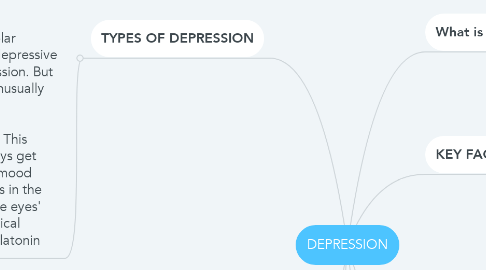DEPRESSION
by Rica Ito II


1. TYPES OF DEPRESSION
1.1. Major depression. The classic depression type, major depression is a state where a dark mood is all-consuming and one loses interest in activities, even ones that are usually pleasurable. Persistent depressive disorder. Formerly called "dysthymia," this type of depression refers to low mood that has lasted for at least two years but may not reach the intensity of major depression. Bipolar disorder. People with bipolar disorder—once known as manic-depressive disease—have episodes of depression. But they also go through periods of unusually high energy order activity. Seasonal affective disorder (SAD). This type of depression emerges as days get shorter in the fall and winter. The mood change may result from alterations in the body's natural daily rhythms, in the eyes' sensitivity to light, or in how chemical messengers like serotonin and melatonin
2. What is Depression?
2.1. Depression is a state of low mood and aversion to activity. It can affect a person's thoughts, behavior, motivation, feelings and sense of well-being. It may feature sadness, difficulty in thinking and concentration and a significant increase or decrease in appetite and time spent sleeping.
3. KEY FACTS
3.1. * Depression is a common mental disorder. Globally, more than 264 million people of all ages suffer from depression.
4. SYMPTOMS OF DEPRESSION
4.1. • Feeling sad or having a depressed mood • Loss of interest or pleasure in activities once enjoyed • Changes in appetite — weight loss or gain unrelated to dieting • Trouble sleeping or sleeping too much • Loss of energy or increased fatigue Increase in purposeless physical activity (e.g., hand-wringing or pacing) or slowed movements and speech (actions observable by others) • Feeling worthless or guilty • Difficulty thinking, concentrating or making decisions • Thoughts of death or suicide
5. PREVENTIONS
5.1. 1. Take steps to control stress 2. Reach out to family and friends 3. Get treatment at the earliest sign of a problem 4. Consider getting long-term maintenance treatment
6. HOW DOES DEPRESSION AFFECT THE BRAIN?
6.1. There are three parts of the brain that appear to play a role in MDD: the hippocampus, amygdala, and prefrontal cortex. The hippocampus is located near the center of the brain. It stores memories and regulates the production of a hormone called cortisol. The body releases cortisol during times of physical and mental stress, including during times of depression.
6.1.1. The hippocampus is located near the center of the brain. It stores memories and regulates the production of a hormone called cortisol. The body releases cortisol during times of physical and mental stress, including during times of depression.
6.1.1.1. Many researchers believe high cortisol levels play the biggest role in changing the physical structure and chemical activities of the brain, triggering the onset of MDD. Normally, cortisol levels are highest in the morning and decrease at night. In people with MDD, however, cortisol levels are always elevated, even at night.
